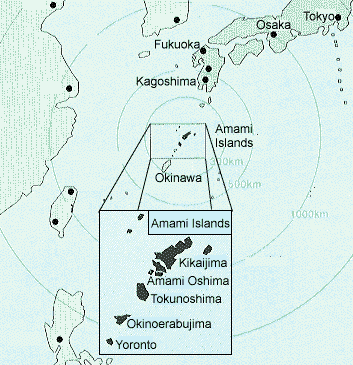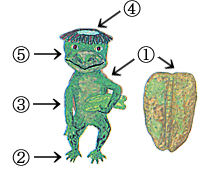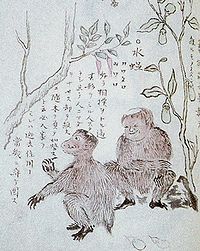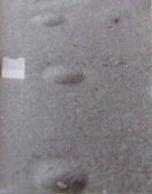
March 1, 2009
Guest blogger Brent Swancer shares what he knows about the Kenmun. My appreciation for his contribution. ~ Loren.
Kenmun
by Brent Swancer
Recently, I wrote here at Cryptomundo about the mysterious Yamapikarya of Iriomote island. However, this mystery cat is not the only cryptid that makes its home in Japan’s Ryukyu Islands. On the island of Amami Oshima (Amami big island), there have long been stories of a hairy, monkey-like creature known as the Kenmun. Let us now take a look once more into these Southern islands of Japan, and the mysteries they hide.

Amami Oshima is the largest island in the Amami chain of islands, in the Northern part of the Ryukyu archipelago. The island is part of Kagoshima prefecture rather than Okinawa prefecture, which comprises the Southern part of the archipelago. It is 274 square miles in area, with mountainous, forested terrain.

Amami Oshima is notable for being the home of the Amami black rabbit (Pentalagus furnessi), shown above, a rabbit, which demonstrates apparent hare ancestral traits, found only on this island and Toku-no island, and no where else in the world.
The Kenmun, also known as the Kunmon, Kunmu, and Nebuzawa, is said to be around 1 to 1.3 meters tall, about the size of a 5 or 6 year old child. It is covered in kinky, red or black hair, that looks mussed and dirty. The Kenmun has a face that is most often described as being like that of a monkey, but also sometimes as dog-like. It is a nocturnal animal, with eyes that glow red in the dark when light catches them. The creature’s arms are disproportionately long compared to the legs, and it is said to be an agile and powerful climber.

The traditional appearance of a Kappa, with the key to the above drawing:
1) Shell
2) Webbed hands and feet
3) Elastic arms
4) Plate (When there is water in this plate, the Kappa has amazing strength.)
5) A tapering mouth
The Kenmun is mostly thought of as another type of Kappa (a sort of Japanese water imp), and old folkloric stories on the animal even describe it as having a cup-like thing on its head, just like the Kappa.

The Kenmun is said to be highly arboreal, making its home primarily in banyan trees, yet it is also a good swimmer, and is thought to prefer habitat near water such as rivers or the sea. It’s favorite foods are said to be fish, crab, and octopus, as well as shellfish and snails. Indeed it is thought that a sure sign of a Kenmun’s tree is the shellfish and snail shells littering the area under it. The creature is said to be particularly fond of fish eyes, which it will pop out and eat with relish.

A prominent feature of the Kenmun is its powerful stench, variously described as smelling like goat, horse, and rotting yams. The smell is believed to instill great fear in animals that come into contact with it, and there have been modern accounts of this. For instance, in 1973, a rancher reported that as he moved his cows to pasture, they suddenly became spooked and refused to move. It was strange since they had never acted this way before. The curious rancher took a look around and didn’t see anything unusual, but he became aware of a thick, pungent stench in the air. It was not until the smell passed that the cows finally regained their composure. Similar effects have often been reported on horses and dogs.
Although mostly considered as harmless, the Kenmun has a somewhat bad reputation nevertheless. In folklore, it was thought to be a trickster as well as a bit headstrong, known to challenge travelers to wrestling matches. In more modern reports, the creatures are said to steal fish or bait from fishermen, and indeed Kenmun are most often seen by fisherman fishing at night. Some more violent behavior includes shrieking at passerby and hurling rocks or stones. There have even been accounts of homes being besieged by rock throwing Kenmun. One man told of seeing a small, dark form sitting alone on the beach one evening. When he called out to it, the figure suddenly whirled around in surprise and the man was astonished to see that it was a hairy creature like a small ape. This creature proceeded to start throwing rocks at the terrified man, even chasing him to his nearby home, where it continued to pelt the dwelling with rocks for some time before leaving the area.
Although the Kenmun has long been sighted by islanders, physical evidence has mostly taken the form of footprints that turn up from time to time.

In November, 1986, a man by the name of Isamu Satoyama photographed a series of strange tracks in the sand on a secluded beach. The tracks went on for 500 meters, and measured 10 cm by 30 cm in diameter. In more recent years, very few tracks have been found and eyewitness reports are rare.
The Kenmun is not the only type of creature like this to be found in the Ryukyu islands. It is very similar to another type of mysterious creature known as the Kijimuna, which is said to live in the more Southern Okinawa prefecture.
Much appreciation to Brent for his guest blog. – Loren
About Loren Coleman
Loren Coleman is one of the world’s leading cryptozoologists, some say “the” leading living cryptozoologist. Certainly, he is acknowledged as the current living American researcher and writer who has most popularized cryptozoology in the late 20th and early 21st centuries.
Starting his fieldwork and investigations in 1960, after traveling and trekking extensively in pursuit of cryptozoological mysteries, Coleman began writing to share his experiences in 1969. An honorary member of Ivan T. Sanderson’s Society for the Investigation of the Unexplained in the 1970s, Coleman has been bestowed with similar honorary memberships of the North Idaho College Cryptozoology Club in 1983, and in subsequent years, that of the British Columbia Scientific Cryptozoology Club, CryptoSafari International, and other international organizations. He was also a Life Member and Benefactor of the International Society of Cryptozoology (now-defunct).
Loren Coleman’s daily blog, as a member of the Cryptomundo Team, served as an ongoing avenue of communication for the ever-growing body of cryptozoo news from 2005 through 2013. He returned as an infrequent contributor beginning Halloween week of 2015.
Coleman is the founder in 2003, and current director of the International Cryptozoology Museum in Portland, Maine.
Filed under Cryptomundo Exclusive, CryptoZoo News, Guest Blog, Proto-Pygmies